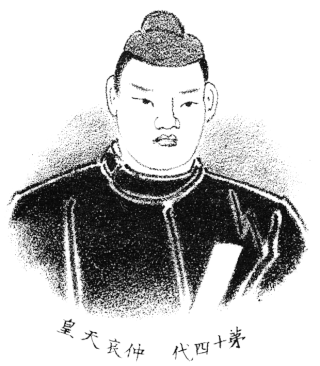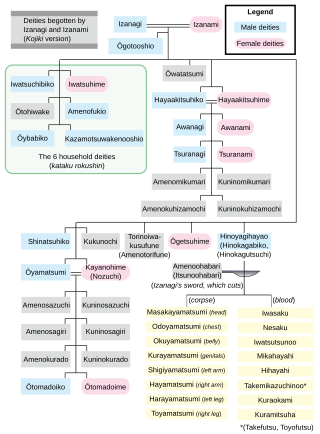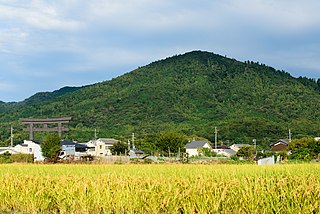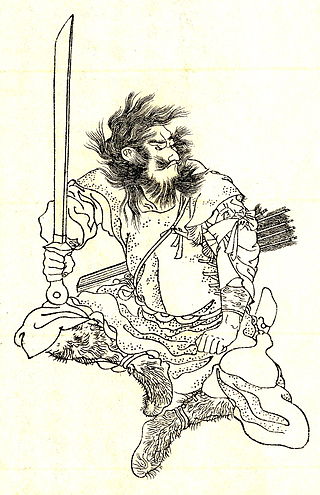
Emperor Chūai, also known as Tarashinakatsuhiko no Sumeramikoto (足仲彦天皇) was the 14th legendary Emperor of Japan, according to the traditional order of succession. Both the Kojiki, and the Nihon Shoki record events that took place during Chūai's alleged lifetime. Chūai is the first monarch to ascend the throne who was not a son of the previous Emperor as the latter's only child died young. He is also noted for having his capital in Kyushu, rather than Yamato like his predecessors. The records state that Chūai had a wife named Okinagatarashihime-no-Mikoto, and 2 consorts that all bore him 4 children.

The Nihon Shoki (日本書紀), sometimes translated as The Chronicles of Japan, is the second-oldest book of classical Japanese history. The book is also called the Nihongi. It is more elaborate and detailed than the Kojiki, the oldest, and has proven to be an important tool for historians and archaeologists as it includes the most complete extant historical record of ancient Japan. The Nihon Shoki was finished in 720 under the editorial supervision of Prince Toneri with the assistance of Ō no Yasumaro and presented to Empress Genshō. The book is also a reflection of Chinese influence on Japanese civilization. In Japan, the Sinicized court wanted written history that could be compared with the annals of the Chinese.

The Hayato (隼人), which is Japanese for "falcon-people", were a people of ancient Japan who lived in the Satsuma and Ōsumi regions of southern Kyushu during the Nara period. They frequently resisted Yamato rule. After their subjugation they became subjects of the government under Ritsuryō, and the Ministry of the Military had an office known as the Hayato-shi (隼人司) in charge of their governance. The name also came into use by samurai as a title, Hayato no suke (隼人助). In modern times, Hayato is a Japanese male given name.

Ōyama-tsumi or Ohoyama-tsumi, also Ōyama-tsumi-mi'oya-no-mikoto (大山祇御祖命), is a god of mountains, sea, and war in Japanese mythology. He is an elder brother of Amaterasu and Susanoo. His other names are Watashi-no-Ōkami (和多志大神) and Sakatoke (酒解神).
Umisachi-hiko (海佐知毘古/海幸彦), in Japanese mythology and folklore, was a deity of the bounty of the sea and enchanted fisherman.

Ugayafukiaezu no Mikoto (鵜葺草葺不合命) is a Shinto kami, and is in Japanese mythology, the father of Japan's first Emperor, Emperor Jimmu.

Yamato Takeru, originally Prince Ousu, was a Japanese folk hero and semi-legendary prince of the imperial dynasty, son of Emperor Keikō, who is traditionally counted as the 12th Emperor of Japan. The kanji spelling of his name varies: it appears in the Nihon Shoki as 日本武尊 and in the Kojiki as 倭建命.

Konohanasakuya-hime is the goddess of Mount Fuji and all volcanoes in Japanese mythology; she is also the blossom-princess and symbol of delicate earthly life. She is often considered an avatar of Japanese life, especially since her symbol is the sakura.

Mount Miwa or Mount Mimoro is a mountain located in the city of Sakurai, Nara Prefecture, Japan. It has been an important religious and historical mountain in Japan, especially during its early history, and serves as a holy site in Shinto. The entire mountain is considered sacred, and is home to one of the earliest Shinto shrines, Ōmiwa Shrine. Several burial mounds from the Kofun period can be found around the mountain.

Asuka-dera (飛鳥寺), also known as Hōkō-ji (法興寺), is a Buddhist temple in Asuka, Nara. Asuka-dera is regarded as one of the oldest temples in Japan.
In Japanese mythology, the tenson kōrin (天孫降臨) is the descent of Amaterasu's grandson Ninigi-no-Mikoto from Heaven (Takamagahara) to Ashihara no Nakatsukuni; according to legend, the direct place of descent is at Takachiho-gawara in Japan. Following the tenson kōrin, Ninigi's son, Hoori, was born.

Ōmononushi is a kami in Japanese mythology associated with Mount Miwa in Sakurai, Nara Prefecture. He is closely linked in the imperial myth cycle recorded in the Kojiki and the Nihon Shoki with the earthly kami Ōkuninushi (Ōnamuchi); indeed, the latter text treats 'Ōmononushi' as another name for or an aspect - more precisely, the spirit or mitama - of Ōnamuchi.

Mizushima (水島) is a small uninhabited coastal limestone island at the mouth of the Kuma River at the northern end of the Yatsushiro Sea in Yatsushiro, Kumamoto Prefecture, Japan. An episode in the Nihon Shoki explains how the isle gained its name: on the eleventh day of the fourth month of the eighteenth year of the reign of Emperor Keikō, the Emperor, near the end of his tour of inspection of Tsukushi, laid anchor at the island and partook of food. When he then asked Ohidari (小左) for water to drink, he was at a loss, there being no ready source to hand; praying to the gods, a spring issued forth, which he drew and proffered to the Heavenly Sovereign; from this the isle takes its name of "water island". The island also features in two poems by Prince Nagata in the Man'yōshū. As a joint designation with the local atmospheric and optical phenomenon known as Shiranui, Mizushima is a nationally designated Place of Scenic Beauty. It also forms part of the Japan Heritage "story" The Story of Masons who Developed Yatsushiro: Masonry Legacy in the Town of Masons.
Hosuseri (火須勢理命) is a god that appears in Japanese mythology. Second child of Ninigi-no-Mikoto and Konohanasakuya-hime. He is considered to be the great-uncle of Emperor Jimmu.
Ahiratsu-hime was the first wife of Emperor Jimmu, first Emperor of Japan. Jimmu later married Himetataraisuzu-hime who became the first Empress of Japan, and whose children inherited the throne. Her son Tagishimimi would attempt to seize power violently due to not inheriting the throne.
Inahi no Mikoto was a Japanese legendary character. In Japanese traditional mythology, he was a brother of Emperor Jimmu, the first Emperor who according to tradition lived in the 7th century BC. His name Inahi means "boiled rice".

Itsuse no Mikoto is a Japanese deity. He was the older brother of Emperor Jimmu.
Mikeiri no Mikoto is a Japanese deity. He was the older brother of Jimmu. While playing a minor role in the Nihon Shoki, he has a prominent local tradition at Takachiho Shrine of which he is the main deity. There is an annual festival for him called Shishikake Festival.
Konohanachiru-hime is a Japanese goddess.

Princess Yamato Totohi Momoso is a Japanese princess buried in Hashihaka Kofun. She was the daughter of Emperor Kōrei. She was the shaman aunt of Emperor Sujin, and is said to have taken her own life after discovering her husband was a snake god.














